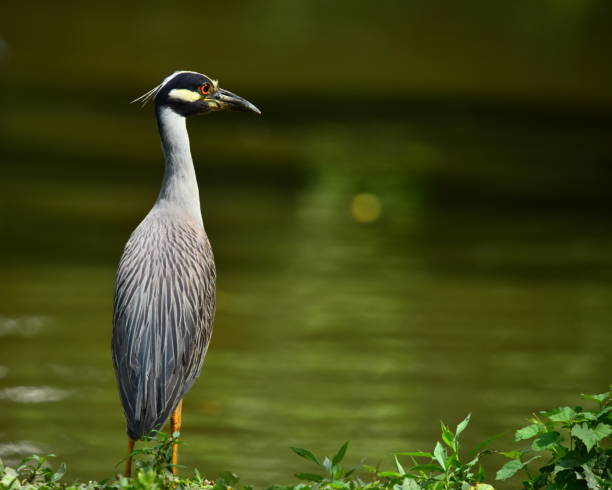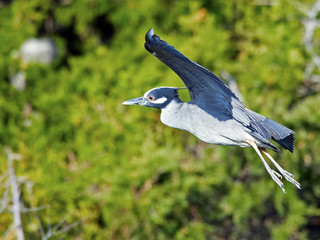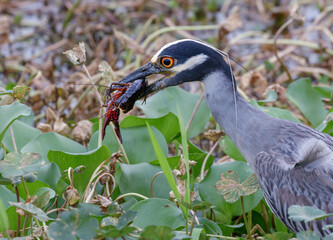Table of Contents
Scientific Classification
| Kingdom | Animalia |
| Phylum | Chordata |
| Class | Aves |
| Order | Pelecaniformes |
| Family | Ardeidae |
| Genus | Nyctanassa |
| Species | Nyctanassa violacea |
| Scientific Name | Nyctanassa violacea |
Description
The Yellow-Crowned Night Heron is a medium-sized wading bird known for its distinctive look. It sports slate-gray feathers, a compact body, and long legs that are perfect for foraging in shallow waters. Its most notable feature is the bright yellow crown and head markings, which stand out against its dark grayish-black face. The heron has striking red-orange eyes and a robust black bill that aids in catching its prey. Juvenile herons are brownish with white spots, which help them blend in and avoid predators.

Distribution
The Yellow-Crowned Night Heron is mainly located in the Americas, extending through Central America and into northern South America. Additionally, some populations can be found on the Caribbean islands. These birds exhibit partial migratory behavior, with northern populations moving southward during the colder months.
Habitat
This species flourishes in wetland environments. You can frequently spot it around coastal marshes, swamps, mangroves, and riverbanks. It favors areas with dense vegetation, which provide excellent cover for both hunting and nesting. The Yellow-Crowned Night Heron prefers habitats with brackish and freshwater. Unlike some herons that are drawn to open waters, it tends to stay close to crabs and other crustaceans, which make up its primary diet.
Diet
The Yellow-Crowned Night Heron primarily feeds on crustaceans, particularly crabs and crayfish. It relies on its sharp eyesight and a patient hunting approach to quietly stalk and capture its prey with its pointed bill. In addition to crustaceans, these birds also eat small fish, insects, snails, and sometimes amphibians. Unlike other herons, this species employs a unique hunting technique; it moves slowly to approach its target before striking with accuracy.

Behavior
Yellow-Crowned Night Herons are primarily nocturnal, showing their most activity at dusk and after dark. Occasionally, they can be seen foraging during daylight hours. While they tend to hunt alone, they often nest in small groups. These herons produce soft croaking sounds and may squawk, particularly during the breeding season or when they feel threatened.
Lifespan
In the wild, the Yellow-Crowned Night Heron typically has a lifespan of about 6 to 10 years, with some individuals living even longer than 10 years. Their longevity is affected by various factors, including predation, habitat destruction, and the availability of food.
Reproduction and Lifecycle
Breeding season varies by location but generally takes place from March to July. During this time, herons form monogamous pairs for nesting. They construct their nests in trees, shrubs, or mangroves, usually close to water. The nests consist of twigs and are lined with leaves and grass. Females typically lay 3 to 5 pale blue-green eggs, which both parents incubate for around 24 to 26 days.
After hatching, the chicks are altricial, meaning they are born helpless and require parental care. Both parents alternate in feeding them regurgitated food. The young herons fledge in 30 to 40 days but continue to depend on their parents for some time before becoming fully independent.

Predators
Adult Yellow-Crowned Night Herons face few natural predators due to their size and flying abilities. However, their eggs and chicks are vulnerable to threats from raccoons, snakes, large birds of prey, and other herons. Additionally, habitat destruction and human disturbances significantly impact their nesting success.
Adaptations
- Yellow-crowned night Herons have developed various adaptations that enhance their chances of survival:
- Specialized Diet: Their robust, thick bills are perfect for cracking open crustacean shells, allowing them to hunt crabs with ease.
- Nocturnal Hunting: By hunting at night, they face less competition for food and avoid daytime predators.
- Camouflaged Plumage: Their gray and brown feathers help them blend into wetland environments, making it more difficult for both predators and prey to detect them.
Keen Vision: These birds possess excellent night vision, enabling them to detect movement even in low light conditions.
Conservation Status
The Yellow-Crowned Night Heron is classified as Least Concern by the IUCN. However, local populations are threatened by habitat loss, pollution, and various human activities.
The Yellow-Crowned Night Heron is a resilient and intriguing bird that thrives in wetland environments. With its distinctive appearance and patient hunting techniques, it plays an essential role in maintaining the balance of crustacean populations within its ecosystem. By safeguarding its habitat, we ensure that future generations can appreciate this remarkable bird of prey in its natural surroundings.



